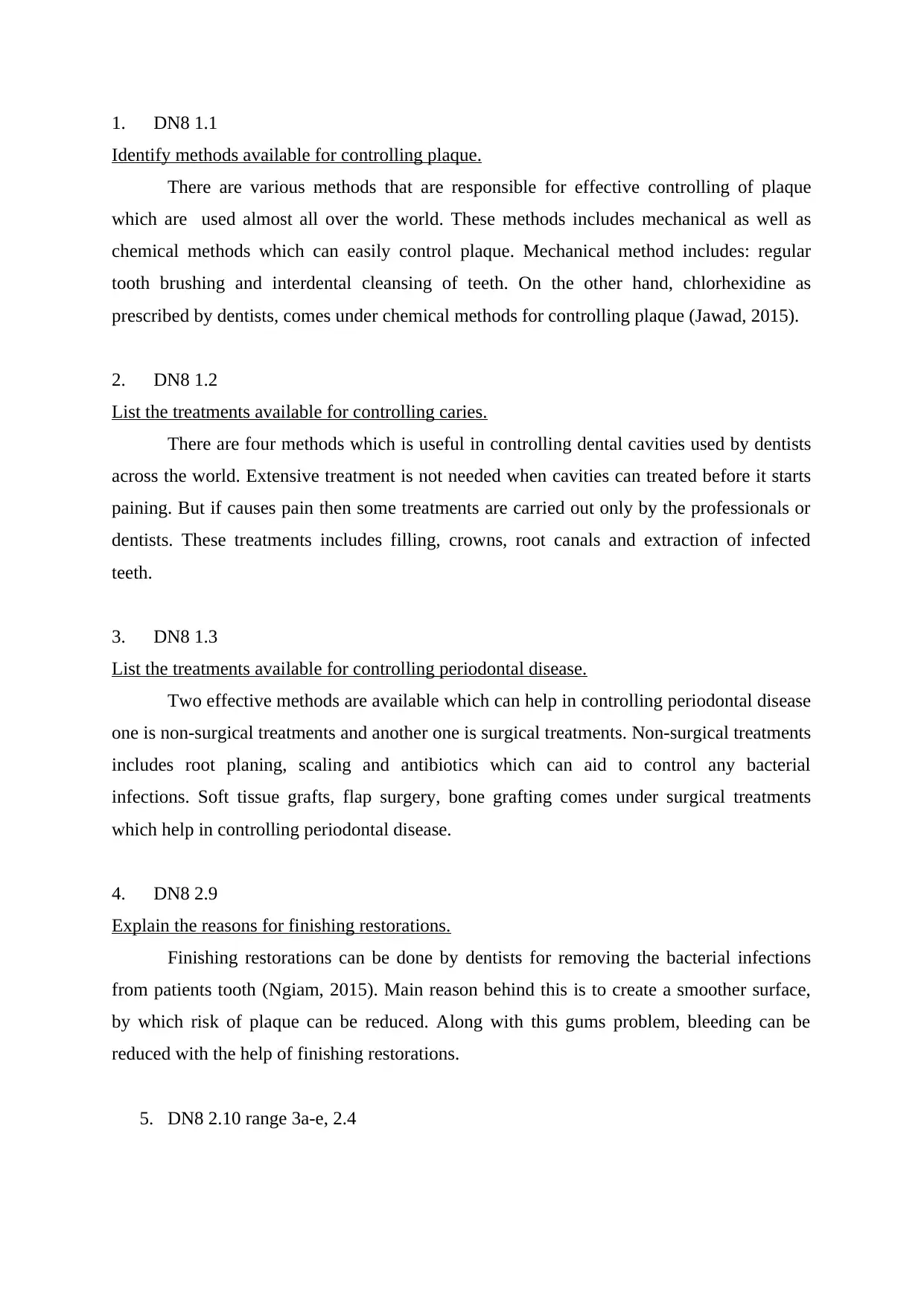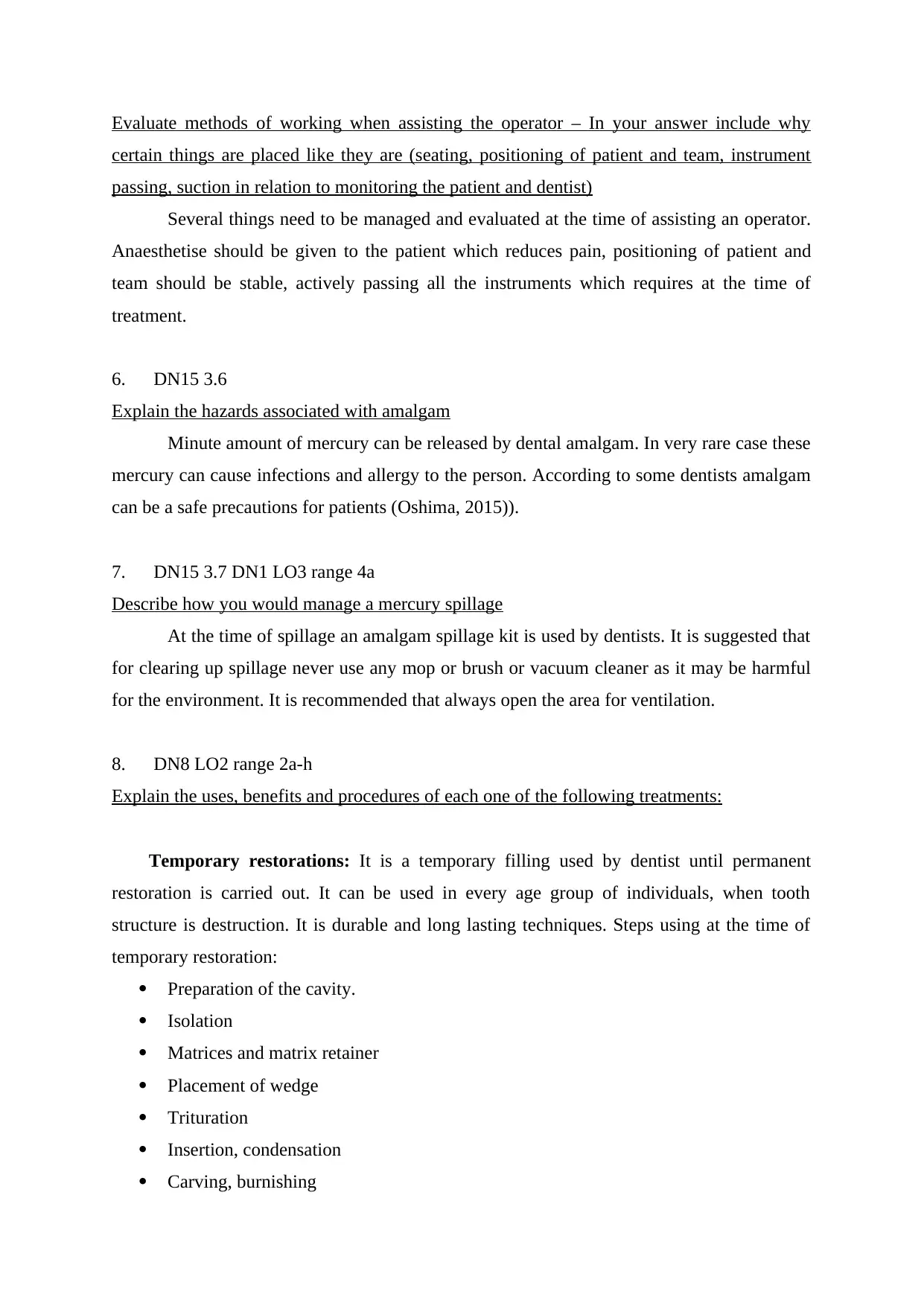Comprehensive Analysis of Dental Treatments Assignment - DN8
VerifiedAdded on 2020/12/09
|4
|1002
|340
Homework Assignment
AI Summary
This assignment solution addresses various aspects of dental treatments, encompassing methods for controlling plaque, treating caries and periodontal disease, and managing related procedures. It details mechanical and chemical methods for plaque control, including tooth brushing and chlorhexidine. Treatments for caries, such as fillings, crowns, root canals, and extractions, are outlined, along with non-surgical and surgical approaches for periodontal disease. The document further explains the importance of finishing restorations, the process of assisting an operator, and the hazards associated with dental amalgam, including mercury spillage management. It also describes the uses, benefits, and procedures of temporary and amalgam restorations, composite restorations, glass ionomer restorations, fluoride treatments, and scaling and polishing. The assignment provides a comprehensive overview of dental treatments and procedures.

1. DN8 1.1
Identify methods available for controlling plaque.
There are various methods that are responsible for effective controlling of plaque
which are used almost all over the world. These methods includes mechanical as well as
chemical methods which can easily control plaque. Mechanical method includes: regular
tooth brushing and interdental cleansing of teeth. On the other hand, chlorhexidine as
prescribed by dentists, comes under chemical methods for controlling plaque (Jawad, 2015).
2. DN8 1.2
List the treatments available for controlling caries.
There are four methods which is useful in controlling dental cavities used by dentists
across the world. Extensive treatment is not needed when cavities can treated before it starts
paining. But if causes pain then some treatments are carried out only by the professionals or
dentists. These treatments includes filling, crowns, root canals and extraction of infected
teeth.
3. DN8 1.3
List the treatments available for controlling periodontal disease.
Two effective methods are available which can help in controlling periodontal disease
one is non-surgical treatments and another one is surgical treatments. Non-surgical treatments
includes root planing, scaling and antibiotics which can aid to control any bacterial
infections. Soft tissue grafts, flap surgery, bone grafting comes under surgical treatments
which help in controlling periodontal disease.
4. DN8 2.9
Explain the reasons for finishing restorations.
Finishing restorations can be done by dentists for removing the bacterial infections
from patients tooth (Ngiam, 2015). Main reason behind this is to create a smoother surface,
by which risk of plaque can be reduced. Along with this gums problem, bleeding can be
reduced with the help of finishing restorations.
5. DN8 2.10 range 3a-e, 2.4
Identify methods available for controlling plaque.
There are various methods that are responsible for effective controlling of plaque
which are used almost all over the world. These methods includes mechanical as well as
chemical methods which can easily control plaque. Mechanical method includes: regular
tooth brushing and interdental cleansing of teeth. On the other hand, chlorhexidine as
prescribed by dentists, comes under chemical methods for controlling plaque (Jawad, 2015).
2. DN8 1.2
List the treatments available for controlling caries.
There are four methods which is useful in controlling dental cavities used by dentists
across the world. Extensive treatment is not needed when cavities can treated before it starts
paining. But if causes pain then some treatments are carried out only by the professionals or
dentists. These treatments includes filling, crowns, root canals and extraction of infected
teeth.
3. DN8 1.3
List the treatments available for controlling periodontal disease.
Two effective methods are available which can help in controlling periodontal disease
one is non-surgical treatments and another one is surgical treatments. Non-surgical treatments
includes root planing, scaling and antibiotics which can aid to control any bacterial
infections. Soft tissue grafts, flap surgery, bone grafting comes under surgical treatments
which help in controlling periodontal disease.
4. DN8 2.9
Explain the reasons for finishing restorations.
Finishing restorations can be done by dentists for removing the bacterial infections
from patients tooth (Ngiam, 2015). Main reason behind this is to create a smoother surface,
by which risk of plaque can be reduced. Along with this gums problem, bleeding can be
reduced with the help of finishing restorations.
5. DN8 2.10 range 3a-e, 2.4
Paraphrase This Document
Need a fresh take? Get an instant paraphrase of this document with our AI Paraphraser

Evaluate methods of working when assisting the operator – In your answer include why
certain things are placed like they are (seating, positioning of patient and team, instrument
passing, suction in relation to monitoring the patient and dentist)
Several things need to be managed and evaluated at the time of assisting an operator.
Anaesthetise should be given to the patient which reduces pain, positioning of patient and
team should be stable, actively passing all the instruments which requires at the time of
treatment.
6. DN15 3.6
Explain the hazards associated with amalgam
Minute amount of mercury can be released by dental amalgam. In very rare case these
mercury can cause infections and allergy to the person. According to some dentists amalgam
can be a safe precautions for patients (Oshima, 2015)).
7. DN15 3.7 DN1 LO3 range 4a
Describe how you would manage a mercury spillage
At the time of spillage an amalgam spillage kit is used by dentists. It is suggested that
for clearing up spillage never use any mop or brush or vacuum cleaner as it may be harmful
for the environment. It is recommended that always open the area for ventilation.
8. DN8 LO2 range 2a-h
Explain the uses, benefits and procedures of each one of the following treatments:
Temporary restorations: It is a temporary filling used by dentist until permanent
restoration is carried out. It can be used in every age group of individuals, when tooth
structure is destruction. It is durable and long lasting techniques. Steps using at the time of
temporary restoration:
Preparation of the cavity.
Isolation
Matrices and matrix retainer
Placement of wedge
Trituration
Insertion, condensation
Carving, burnishing
certain things are placed like they are (seating, positioning of patient and team, instrument
passing, suction in relation to monitoring the patient and dentist)
Several things need to be managed and evaluated at the time of assisting an operator.
Anaesthetise should be given to the patient which reduces pain, positioning of patient and
team should be stable, actively passing all the instruments which requires at the time of
treatment.
6. DN15 3.6
Explain the hazards associated with amalgam
Minute amount of mercury can be released by dental amalgam. In very rare case these
mercury can cause infections and allergy to the person. According to some dentists amalgam
can be a safe precautions for patients (Oshima, 2015)).
7. DN15 3.7 DN1 LO3 range 4a
Describe how you would manage a mercury spillage
At the time of spillage an amalgam spillage kit is used by dentists. It is suggested that
for clearing up spillage never use any mop or brush or vacuum cleaner as it may be harmful
for the environment. It is recommended that always open the area for ventilation.
8. DN8 LO2 range 2a-h
Explain the uses, benefits and procedures of each one of the following treatments:
Temporary restorations: It is a temporary filling used by dentist until permanent
restoration is carried out. It can be used in every age group of individuals, when tooth
structure is destruction. It is durable and long lasting techniques. Steps using at the time of
temporary restoration:
Preparation of the cavity.
Isolation
Matrices and matrix retainer
Placement of wedge
Trituration
Insertion, condensation
Carving, burnishing

Finishing, polishing.
Amalgam restorations: This treatment is used to fill the infected tooth caused by
cavities. Its benefit is that it is a long lasting treatment and least expensive as compared to
other treatments. Five major steps at the time of amalgam application:
Proportioning and dispensing.
Trituration.
Condensation.
Carving.
Polishing.
Composite restorations: This treatment is used to modify the shape and size of tooth,
for core building and luting. Benefits of composite restoration is it can easily be repaired in
future, it has a good longevity. Steps of placing composite restoration:
Trimming the tooth
Acid etching the enamel.
Applying the bonding agent
Placing dental composite.
Curing the restoration.
Final shaping and polishing of tooth.
Glass ionomer restorations: This treatment is used by the people who have problem in
their front teeth, around the neck of teeth and roots of the teeth. It is benefited to bond the
tooth structure without any bonding agents. Steps followed at the time of glass ionomer
restoration:
Removes cavities.
Placing of glass ionomer.
Smoothing of teeth.
Fluoride treatments: This treatment is used as a necessary oral health care which
help in building teeth strong and cavity free. This treatment benefits the patients by restoring
minerals to infected surface of tooth.
Scaling and polishing: This treatment is used to prevent from plaque and gum
diseases. It is a safe treatment and remove all the gunk from your gums and teeth.
REFERENCES
Amalgam restorations: This treatment is used to fill the infected tooth caused by
cavities. Its benefit is that it is a long lasting treatment and least expensive as compared to
other treatments. Five major steps at the time of amalgam application:
Proportioning and dispensing.
Trituration.
Condensation.
Carving.
Polishing.
Composite restorations: This treatment is used to modify the shape and size of tooth,
for core building and luting. Benefits of composite restoration is it can easily be repaired in
future, it has a good longevity. Steps of placing composite restoration:
Trimming the tooth
Acid etching the enamel.
Applying the bonding agent
Placing dental composite.
Curing the restoration.
Final shaping and polishing of tooth.
Glass ionomer restorations: This treatment is used by the people who have problem in
their front teeth, around the neck of teeth and roots of the teeth. It is benefited to bond the
tooth structure without any bonding agents. Steps followed at the time of glass ionomer
restoration:
Removes cavities.
Placing of glass ionomer.
Smoothing of teeth.
Fluoride treatments: This treatment is used as a necessary oral health care which
help in building teeth strong and cavity free. This treatment benefits the patients by restoring
minerals to infected surface of tooth.
Scaling and polishing: This treatment is used to prevent from plaque and gum
diseases. It is a safe treatment and remove all the gunk from your gums and teeth.
REFERENCES
⊘ This is a preview!⊘
Do you want full access?
Subscribe today to unlock all pages.

Trusted by 1+ million students worldwide

Jawad, H., Hodson, N. A. and Nixon, P. J., 2015. A review of dental treatment of head and neck
cancer patients, before, during and after radiotherapy: part 1. British dental journal. 218(2).
p.65.
Ngiam, J. and Cistulli, P. A., 2015. Dental treatment for paediatric obstructive sleep apnea. Paediatric
respiratory reviews. 16(3). pp.174-181.
Oshima, M. and Tsuji, T., 2015. Whole tooth regeneration as a future dental treatment. In Engineering
Mineralized and Load Bearing Tissues (pp. 255-269). Springer, Cham.
cancer patients, before, during and after radiotherapy: part 1. British dental journal. 218(2).
p.65.
Ngiam, J. and Cistulli, P. A., 2015. Dental treatment for paediatric obstructive sleep apnea. Paediatric
respiratory reviews. 16(3). pp.174-181.
Oshima, M. and Tsuji, T., 2015. Whole tooth regeneration as a future dental treatment. In Engineering
Mineralized and Load Bearing Tissues (pp. 255-269). Springer, Cham.
1 out of 4
Related Documents
Your All-in-One AI-Powered Toolkit for Academic Success.
+13062052269
info@desklib.com
Available 24*7 on WhatsApp / Email
![[object Object]](/_next/static/media/star-bottom.7253800d.svg)
Unlock your academic potential
Copyright © 2020–2025 A2Z Services. All Rights Reserved. Developed and managed by ZUCOL.





